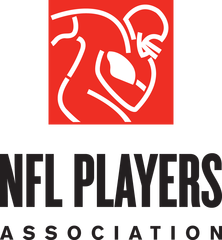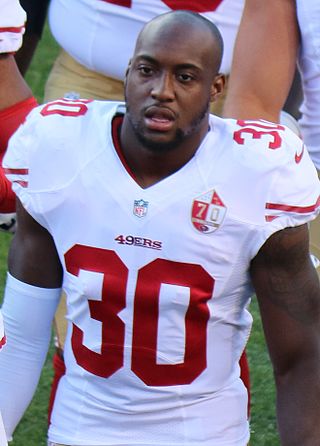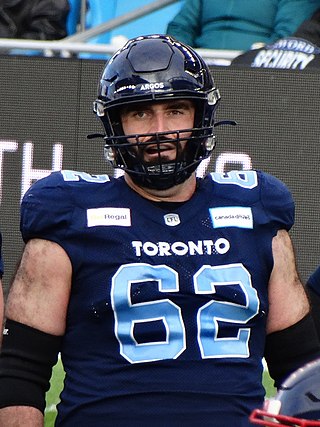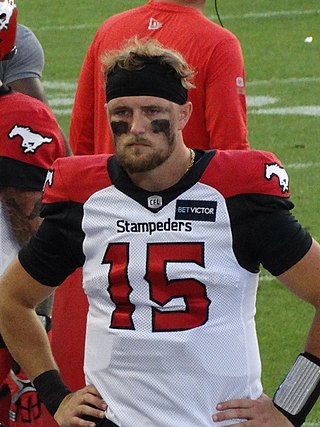Related Research Articles

The Canadian Football League is a professional sports league in Canada. The CFL is the highest level of competition in Canadian football. The league consists of nine teams, each located in a city in Canada. They are divided into two divisions: four teams in the East Division and five teams in the West Division. As of 2024, it features a 21-week regular season in which each team plays 18 games with three bye weeks. This season traditionally runs from mid-June to early November. Following the regular season, six teams compete in the league's three-week playoffs, which culminate in the Grey Cup championship game in late November. The Grey Cup is one of Canada's largest annual sports and television events. The CFL was officially named on January 19, 1958, upon the merger between the Interprovincial Rugby Football Union or "Big Four" and the Western Interprovincial Football Union.
In professional sports, a salary cap is an agreement or rule that places a limit on the amount of money that a team can spend on players' salaries. It exists as a per-player limit or a total limit for the team's roster, or both. Several sports leagues have implemented salary caps, using them to keep overall costs down, and also to maintain a competitive balance by restricting richer clubs from entrenching dominance by signing many more top players than their rivals. Salary caps can be a major issue in negotiations between league management and players' unions because they limit players' and teams' ability to negotiate higher salaries even if a team is operating at significant profits, and have been the focal point of several strikes by players and lockouts by owners and administrators.

The National Football League Players Association, or NFLPA, is the labor union representing National Football League (NFL) players. The NFLPA, which has headquarters in Washington, D.C., is led by president J. C. Tretter and executive director Lloyd Howell. Founded in 1956, the NFLPA is the second-oldest labor union of the four major North American professional sports leagues; it was established to provide players with formal representation to negotiate compensation and the terms of a collective bargaining agreement (CBA). The NFLPA is a member of the AFL–CIO, the largest federation of unions in the United States.
The injured reserve list is a designation used in North American professional sports leagues for athletes who suffer injuries and become unable to play. The exact name of the list varies by league; it is known as "injured reserve" in the National Football League (NFL) and National Hockey League (NHL), the "injured list" in the Canadian Football League (CFL), and the injured list in Major League Baseball (MLB). The National Basketball Association (NBA) does not have a direct analog to an injured reserve list, instead using a more general-purpose "inactive list" that does not require a player to be injured.
The NFL collective bargaining agreement (CBA) is a labor agreement which reflects the results of collective bargaining negotiations between the National Football League Players Association (NFLPA) and National Football League (NFL). The labor agreement classifies distribution of league revenues, sets health and safety standards and establishes benefits, including pensions and medical benefits, for all players in the NFL. The first collective bargaining agreement was reached in 1968 after player members of the NFLPA voted to go on strike to increase salaries, pensions and benefits for all players in the league. Later negotiations of the collective bargaining agreement called for injury grievances, a guaranteed percentage of revenues for players, an expansion of free agency and other issues impacting the business of the NFL. The NFLPA and team owners have negotiated seven different agreements since 1968.
John Ojo is a former American football cornerback. He was a member of the Saskatchewan Roughriders of the Canadian Football League (CFL). He made his professional debut for the Edmonton Eskimos (CFL) in 2014 after playing college football at Florida A&M University. He has also been a member of the New York Jets of the National Football League (NFL).

Prince Charles Iworah is an American football cornerback or the St. Louis Battlehawks of the United Football League (UFL). He played college football at Western Kentucky, and was drafted by the San Francisco 49ers in the seventh round of the 2016 NFL Draft.
Tommylee Lewis is an American football wide receiver and return specialist for the Calgary Stampeders of the Canadian Football League (CFL). He played college football at Northern Illinois and signed with the Saints as an undrafted free agent in 2016.
Jake Lampman is an American football wide receiver who is currently a free agent. He played college football at Ferris State. He was signed by the New Orleans Saints as an undrafted free agent after the 2016 NFL Draft.

Will Clapp is an American football center for the Los Angeles Chargers of the National Football League (NFL). He played college football at Louisiana State University.
Teo Redding is an American football wide receiver for the Houston Roughnecks of the United Football League (UFL). He attended Michigan Collegiate High School. He played college football at Bowling Green and was originally signed by the Detroit Lions as an undrafted free agent in 2018. He has also been a member of the Washington Redskins, Green Bay Packers, New York Guardians, and Montreal Alouettes.
The 2020 CFL season would have been the 67th season of modern-day Canadian football. Officially, it would have been the 63rd season of the Canadian Football League.

Deon Yelder is an American football tight end who is a free agent. He played college football at Western Kentucky and signed with the New Orleans Saints as an undrafted free agent in 2018. Yelder won a Super Bowl title as part of the Kansas City Chiefs in Super Bowl LIV.

Iosua Opeta is an American football guard for the Philadelphia Eagles of the National Football League (NFL). After playing college football for Weber State, he was signed by the Eagles as an undrafted free agent in 2019.

Jordan Kunaszyk is an American football linebacker for the Cleveland Browns of the National Football League (NFL). He played college football at California and signed with the Carolina Panthers as an undrafted free agent in 2019.
Wesley Ed Hills is an American professional gridiron football running back for the Michigan Panthers of the United Football League (UFL). He played college football for Delaware and Slippery Rock. He signed with the Arizona Cardinals as an undrafted free agent in 2019 and played for the Detroit Lions of the National Football League (NFL), Hamilton Tiger-Cats of the Canadian Football League (CFL), and New Orleans Breakers of the United States Football League (USFL).

Ryan Kenneth Hunter is a Canadian gridiron football offensive lineman for the Toronto Argonauts of the Canadian Football League (CFL). He has also been a member of the Kansas City Chiefs and Los Angeles Chargers of the National Football League (NFL).

Thomas Mason Stevens is an American professional Canadian football quarterback for the Calgary Stampeders of the Canadian Football League (CFL). He played college football at Mississippi State and was drafted by the New Orleans Saints in the seventh round of the 2020 NFL Draft as a quarterback. Stevens initially played football at Penn State before transferring to Mississippi State. He played high school football at Decatur Central High School (DCHS) in Indianapolis. He played safety and quarterback in high school. Stevens has also been a member of the Carolina Panthers and New York Giants.
Josiah Bronson is an American football defensive end for the Memphis Showboats of the United Football League (UFL). He played college football at Washington and signed with New Orleans Saints as an undrafted free agent in 2021.
Miller Forristall is an American football tight end for the Los Angeles Rams of the National Football League (NFL). He played college football at Alabama.
References
- ↑ Thomas, Jeanna (September 2, 2017). "Here's how NFL practice squads work". SB Nation. New York, NY: Vox Media.
- ↑ "Here’s how NFL practice squads work".
- ↑ Cantor 2008, p. 95.
- ↑ "NFL Player Limit (40)". Herald News . February 19, 1965. Retrieved May 23, 2020– via Newspapers.com.
- ↑ Roesler, Bob (September 29, 1968). "Behind the Sports Scene". The Times-Picayune. New Orleans. sec. 6, p. 2.
- ↑ Belloni, Nat (August 22, 1968). "Bliss Among the Tall Pines". New Orleans States-Item. New Orleans. p. 17.
- ↑ Roesler, Bob (May 6, 1970). "Behind the Sports Scene". The Times-Picayune. New Orleans. sec. 2, p. 6.
- ↑ McMillen, Larry (September 11, 1974). "Williams Heads Cuts by Saints". The Times-Picayune. New Orleans. sec. 3, p. 1.
- ↑ Marshall, Bob (September 13, 1977). "Four More Saints to Go Today". The States-Item. New Orleans. p. C1.
- ↑ Janofsky, Michael (November 8, 1982). "Rozelle: Super Bowl Rooms to be Released". The Times-Picayune/The States-Item. New Orleans. sec. 3, p. 3.
- ↑ "Houston Texans - Arian Foster Profile". Houston Texans. houstontexans.com. Retrieved August 21, 2014.
- ↑ "Patriots.com". Patriots.com. New England Patriots. Archived from the original on August 21, 2014. Retrieved August 21, 2014.
- ↑ Dunleavy, Ryan (May 23, 2020). "What is a NFL futures contract? Closer look at first 12 Giants signed this offseason". NJ.com. Retrieved May 23, 2020.
- ↑ CBA 2020, p. 360.
- ↑ Vitali, Carmen (March 15, 2020). "New CBA Brings Immediate Changes for 2020 NFL Season". Buccaneers.com. Retrieved May 23, 2020.
- 1 2 3 Rapien, James (May 29, 2022). "NFL Makes Changes to Practice Squad Rules Ahead of 2022 Season". SI.com. Retrieved October 15, 2022.
- ↑ "Chiefs could benefit from expansion to 16-man practice squad". Chiefs Wire. July 24, 2020. Retrieved July 27, 2020.
- ↑ Rivera, Joe (August 30, 2023). "NFL practice squad signings: Updated rosters for all 32 teams in 2023". SportingNews. Retrieved December 6, 2023.
- ↑ "NFL reportedly proposes expansion of practice squad and here are the details". CBSSports.com. Retrieved July 27, 2020.
- 1 2 3 "National Football League Management Council and National Football League Players Association (NFLPA) (1993)". Cornell University. 2008. Archived from the original on January 10, 2009. Retrieved May 23, 2020.
- ↑ Tomlinson, Dylan B. (April 1, 2004). "Tice says Vikings should have plenty of motivation". The Post-Crescent . Retrieved May 23, 2020– via Newspapers.com.
- 1 2 "NFL Practice Squads Expand to 10 Players". National Football League. August 19, 2014. Archived from the original on September 11, 2014. Retrieved September 18, 2014.
- ↑ Battista, Judy (March 15, 2020). "NFL players approve CBA: Impact on league in 2020 and beyond". NFL.com.
- ↑ "Chiefs could benefit from expansion to 16-man practice squad". Chiefs Wire. July 24, 2020. Retrieved July 27, 2020.
- 1 2 "NFL–NFLPA Collective Bargaining Agreement 2006" (PDF). NFL.com. March 8, 2006. Retrieved May 23, 2020.
- ↑ Bouchette, Ed (September 22, 2004). "Quarterback Quinn Signs Up for Practice Squad". Pittsburgh Post-Gazette. Retrieved September 19, 2009.
- ↑ Wilson, Aaron (June 22, 2016). "NFL changes rules for practice-squad members". Houston Chronicle . Retrieved June 22, 2016.
- ↑ "NFL–NFLPA Collective Bargaining Agreement 2011" (PDF). NFL Labor. August 4, 2011. Retrieved May 23, 2020.
- 1 2 CBA 2020, p. 172.
- ↑ Reiss, Mike (September 19, 2007). "NFL hunting for answer on how Fox got Patriots video". The Boston Globe. Retrieved July 2, 2009.
- ↑ CFL Roster Makeup — A CFLdb Razzle Document
- 1 2 Rachuk, Stephan (April 24, 2019). "Oliver Luck talks TV deals, Draft and XFL's "Team 9" | XFL2k". XFL2K.com. Retrieved April 25, 2019.
- ↑ "How to Become an NFL Football Player".
- ↑ Dellenger, Ross (June 13, 2018). "The NCAA's Redshirt Rule Change Is a Major Win for Both Coaches and Players". Sports Illustrated . Retrieved July 27, 2018.
- ↑ "A Brief History of Freshman Eligibility and Race in the NCAA". October 22, 2015.
- ↑ "Global additions set to make history in Week 1". June 11, 2019.
- 1 2 Williamson, Bill (June 12, 2008). "International practice-squad players assigned". ESPN. Archived from the original on September 11, 2009.
- 1 2 NFL Expands International Practice Squad Program Archived July 11, 2008, at the Wayback Machine , The News Tribune , May 23, 2008.
- ↑ "Kickalicious says league rejected Lions' attempt to keep him on practice squad". nbcsports.com. September 12, 2013. Retrieved March 18, 2018.
- ↑ Patra, Kevin (May 25, 2017). "International players added to four practice squads". Around the NFL. NFL.com . Retrieved May 27, 2017.
- ↑ "NFL expands program for overseas practice squad players". AP NEWS. May 1, 2018.
- ↑ BARNES: Mexican players who make an active CFL roster will hand over 10% of salary for a scholarship fund
- ↑ Rosen, Dan (January 13, 2021). "NHL realignment, taxi squad for only one season, Daly says in Q&A". NHL.com. Retrieved May 9, 2021.
- ↑ "NHL, NHLPA agree to temporary taxi squads for COVID-19". NHL.com. Retrieved December 27, 2021.